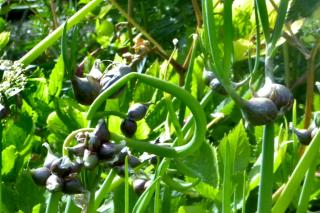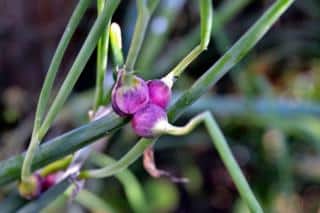

Tree onion is a onion that seems to have everything upside-down: it grows onions at the tip of its stalk!
Tree onion, a summary
Botanical name – Allium cepa proliferum or Allium x proliferum
Common names – Tree onion, Egyptian onion, top-setting onion and even walking onion (favorite name!), rocambole onion
Family – Alliaceae
Type – vegetable bulb, perennial
Height – ± 3 feet (0.90 to 1 meter)
Planting distance – 4 to 6 inches (10 to 15 cm)
Exposure – full sun
Soil – Light, rather sandy and moist
Planting – beginning of Fall or Spring
Harvest – Summer
In the “Rocambole” family, let me have the onion! Great choice! After our feature on rocambole garlic, here is its cousin, the rocambole onion. It’s also commonly called tree onion. This heirloom bulb vegetable is very interesting because once it’s planted, it grows back several years in a row. This gives it yet another name: perennial onion.
Go ahead and plant in October-November or in February-March. To get things right for your “walking onion”, there are a few tips to know:
It’s all set! Time to plant! Here’s the procedure:

Although it generally resists diseases well, tree onion can be attacked by the onion fly.
Bulblets of the rocambole onion can be picked in July-August: at this time, they easily detach from the stem. However, to keep the stems whole and avoid damaging the base of the stems, it’s often preferable to cut those stems that are bearing bulblets. After picking all these small bulbs, spread them out on newspaper for them to dry for a few days in the shade. Make sure the area is dry and well ventilated.
Genetic analysis demonstrates that tree onion is a hybrid of two more common onion: welsh onion, and the common onion.
Well, you can’t: this species only reproduces through its bulbs!
The underground bulbs bear offshoots as they grown and spread. And of course, the bulblets at the top will also take root if planted as shown above. So get your hand on bulbs or bulblets instead of seeds!

Actually, the bulblets are a way for the onion to extend its range: as the stem bends over in Autumn, the bulblets reach the ground where they take root and start a new plant! One foot at a time, out to conquer the world!